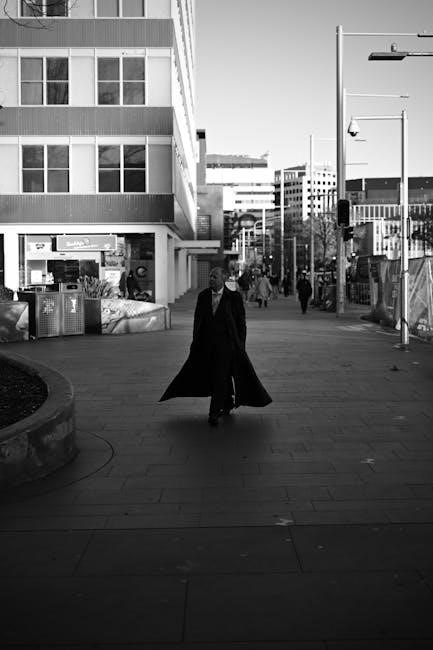Welcome to the Nikon F100 user guide! This manual is designed to help you unlock the full potential of your camera. Reading it thoroughly ensures optimal performance and enhances your photography experience.
Overview of the Nikon F100
The Nikon F100 is a high-performance 35mm film SLR camera introduced in 1999. Designed for both professional photographers and enthusiasts, it combines durability with advanced features. Its robust body, crafted from metal and high-quality plastic, ensures reliability in various shooting conditions. The camera features a 5-area Multi-CAM1300 autofocus system, offering fast and precise focusing. It supports multiple metering modes, including matrix, center-weighted, and spot metering, ensuring accurate exposure control. With a top shutter speed of 1/8000th of a second and compatibility with a wide range of Nikon lenses and accessories, the F100 is a versatile tool for capturing high-quality images. Its ergonomic design and intuitive controls make it a favorite among photographers seeking a balance of power and usability.
Importance of Reading the Manual
Reading the Nikon F100 manual is crucial for mastering its advanced features and optimizing performance. The guide provides detailed explanations of autofocus modes, metering systems, and exposure controls, ensuring photographers can navigate complex settings effectively. It also offers troubleshooting tips and maintenance advice, helping users resolve issues and extend the camera’s lifespan. By understanding the manual, photographers can unlock the F100’s full potential, enhancing their creative control and improving image quality. Keeping the manual handy allows for quick reference, making it an indispensable resource for both beginners and experienced photographers seeking to maximize their camera’s capabilities in various shooting situations.

Key Features
The Nikon F100 boasts a robust build, advanced autofocus with five-area Multi-CAM1300, versatile metering modes, high-speed shutter up to 1/8000s, and compatibility with Nikon lenses and accessories.
Advanced Autofocus System
The Nikon F100 features an advanced autofocus system with the Multi-CAM1300 sensor, offering five-area detection for precise and rapid focusing. This system excels in dynamic AF, ensuring sharp focus on moving subjects. Three modes are available: Single Servo AF for stationary subjects, Continuous Servo AF for tracking motion, and Manual Focus for precise control. The AF mode selector is conveniently located near the lens mount for easy access. This system enhances accuracy and speed, making it ideal for both professionals and enthusiasts capturing diverse photography scenarios, from portraits to action shots, with reliability and consistency.
Exposure Control and Metering
The Nikon F100 offers a sophisticated exposure control system with three metering modes: Matrix, Center-Weighted, and Spot Metering. Matrix Metering provides balanced exposure by analyzing the entire scene, while Center-Weighted prioritizes the central area. Spot Metering measures light from a small, user-selected section, ideal for high-contrast situations. The camera also features exposure compensation, allowing adjustments of ±3 EV in 1/3 increments, and exposure bracketing for capturing multiple exposures of the same scene. These features ensure precise control over lighting, enabling photographers to achieve desired results in various conditions, from bright landscapes to low-light environments. The system’s flexibility and accuracy make it a reliable tool for both professional and enthusiast photographers seeking consistent and optimal exposures.

Operating the Camera
Master the Nikon F100’s intuitive controls for seamless photography. Learn to load film, navigate basic functions, and optimize autofocus for sharp, professional results every time.
Loading Film
Loading film into the Nikon F100 is a straightforward process. Start by pulling up the film rewind knob located on top of the camera to open the back. Carefully insert the film cartridge into the film chamber on the left side. Gently pull out the film leader and align it with the take-up spool. Close the camera back firmly to ensure proper engagement. The camera will automatically advance the film to the first frame. Always check the film counter to confirm the film is loaded correctly. For optimal results, use Nikon-recommended films and avoid exposing the film to direct sunlight during loading. Proper film loading ensures accurate frame counting and consistent image quality.
Basic Camera Controls
The Nikon F100 features intuitive controls designed for easy operation. The main command dial, located on the top right, adjusts aperture and shutter speed. Pressing the exposure compensation button near the dial allows fine-tuning of exposure settings. The mode dial, also on top, offers shooting modes such as Manual (M), Aperture Priority (A), and Shutter Priority (S). The AF mode selector on the front enables switching between Single Servo AF, Continuous Servo AF, and Manual Focus. These controls provide quick access to essential functions, ensuring seamless photography. Understanding these basics is crucial for mastering the camera’s capabilities and capturing high-quality images consistently.

Shooting Modes
The Nikon F100 offers versatile shooting modes, including Manual (M), Aperture Priority (A), Shutter Priority (S), and Program (P). These modes cater to different creative and technical needs.
Understanding the Mode Dial
The Nikon F100 mode dial provides quick access to various shooting modes and settings. Located on the top right, it features Manual (M), Aperture Priority (A), Shutter Priority (S), Program (P), and Scene modes. Each mode offers distinct control levels, from fully automatic to manual, allowing photographers to tailor their approach to different situations. The dial also includes a lock mechanism to prevent accidental mode changes. By rotating the dial, users can seamlessly switch between modes, ensuring efficient and intuitive operation. Familiarizing yourself with the mode dial enhances your ability to adapt to varying lighting conditions and creative demands, making it a key component of mastering the camera’s functionality and achieving desired results in your photography.
Choosing the Right Shooting Mode
Selecting the appropriate shooting mode on the Nikon F100 is crucial for achieving the desired results. The camera offers multiple modes, including Program Mode (P), Aperture Priority (A), Shutter Priority (S), and Manual Mode (M). Program Mode is ideal for everyday shooting, automatically adjusting settings for optimal results. Aperture Priority (A) allows control over depth of field by setting the aperture, while Shutter Priority (S) enables control over motion capture by adjusting shutter speed. Manual Mode (M) provides full creative control, letting you set both aperture and shutter speed. Understanding each mode’s purpose ensures you can adapt to various lighting conditions and creative goals. Experiment with these modes to master their effects and enhance your photography skills. Proper mode selection is key to unlocking the camera’s potential and capturing high-quality images consistently.

Metering Systems
The Nikon F100 features a TLS (Through-The-Lens) exposure metering system with three modes: Matrix, Center-Weighted, and Spot Metering. Each mode provides precise light measurement for accurate exposures.
Types of Metering Modes
The Nikon F100 offers three metering modes to cater to different lighting conditions: Matrix Metering, Center-Weighted Metering, and Spot Metering. Matrix Metering divides the scene into 10 segments, analyzing brightness, color, and composition for balanced exposures. Center-Weighted Metering prioritizes the central 20% of the frame, ideal for portraits and straightforward compositions. Spot Metering measures a small area (4% of the frame) for precise control in high-contrast or challenging lighting scenarios. These modes ensure flexibility, allowing photographers to adapt to various shooting situations and achieve accurate exposures. Each mode can be selected via the camera’s controls, providing a tailored approach to capture the desired results effectively.
Adjusting Metering Settings
Adjusting metering settings on the Nikon F100 is straightforward, allowing photographers to fine-tune exposures. Use the main command dial to set aperture or shutter speed, depending on the mode. For precise adjustments, press the exposure compensation button while rotating the main command dial. The viewfinder displays the exposure level, ensuring accurate control. The camera also features a lock-in memory function for spot metering, enabling measurements from a specific area. These adjustments enhance versatility, catering to various lighting conditions and creative preferences. The F100 supports Matrix, Center-Weighted, and Spot Metering, providing flexibility for photographers to achieve desired results in diverse situations. This adaptability makes the camera a reliable tool for professional and amateur photographers alike.

Flash Photography
The Nikon F100 features a built-in flash for convenience and supports external flash units for enhanced lighting control. It enables effective fill lighting and more powerful illumination in various conditions.
Using the Built-in Flash
The Nikon F100 features a convenient built-in flash that automatically pops up when activated. To use it, simply press the flash activation button located on the front of the camera. The flash is ideal for fill lighting in backlit situations or for adding extra illumination in low-light conditions. It operates in TTL (Through-The-Lens) mode, ensuring accurate exposure by measuring the light reflected off the film. The built-in flash has a guide number of 12 (ISO 100) and covers a wide-angle lens up to 28mm. It also supports various flash modes, such as Auto, Manual, and Repeat, providing flexibility for different shooting scenarios. For best results, avoid using the built-in flash in direct backlight or at extreme angles, as this may cause overexposure or unwanted shadows. Always ensure the flash is fully charged before capturing your shot for optimal performance.
External Flash Units
The Nikon F100 is compatible with a range of external flash units, including the Nikon Speedlight series. These flashes offer greater power and flexibility compared to the built-in flash. To use an external flash, attach it to the camera’s hot shoe or connect it via a sync cord. Dedicated flashes like the SB-28, SB-27, and SB-26 are designed to work seamlessly with the F100, offering advanced features such as TTL metering and wireless operation. External flashes provide more creative control, allowing for off-camera positioning and multiple flash setups. They are ideal for professional photography, offering higher guide numbers and faster recycle times. Always ensure the flash is properly synchronized with the camera for optimal results. Refer to the external flash unit’s manual for detailed instructions on compatibility and operation with the F100.

Autofocus Modes
The Nikon F100 offers advanced autofocus modes, including Single Servo AF for stationary subjects and Continuous Servo AF for tracking moving subjects, ensuring precise focus control in various situations.
Single Servo AF Mode
The Single Servo AF mode on the Nikon F100 is designed for stationary or slowly moving subjects. It focuses once when the shutter release button is pressed halfway, ensuring sharp images by locking focus on your subject. This mode is ideal for portraits, landscapes, or still-life photography, where precise control over focus is essential. The camera uses its advanced 5-area Multi-CAM1300 autofocus sensor to quickly and accurately lock onto your subject, even in challenging lighting conditions. To activate Single Servo AF, simply slide the AF mode selector switch to the “S” position. This mode is praised for its accuracy and ease of use, making it a favorite among photographers who value reliable autofocus performance. By understanding and mastering this mode, you can achieve professional-grade results with your Nikon F100;
Continuous Servo AF Mode
The Continuous Servo AF mode on the Nikon F100 is tailored for capturing dynamic and fast-moving subjects. This mode continuously adjusts focus as the subject moves, ensuring sharp images even during high-speed action. It is ideal for sports, wildlife, and action photography, where precise tracking is crucial. The camera uses predictive focus tracking to anticipate the subject’s movement, delivering accurate results. To activate Continuous Servo AF, slide the AF mode selector switch to the “C” position. This mode is particularly effective in combination with the camera’s advanced 5-area Multi-CAM1300 autofocus system, which provides quick and reliable focus acquisition. By mastering Continuous Servo AF, photographers can confidently capture sharp, in-focus images of moving subjects with ease and precision.

Accessories
The Nikon F100 supports a wide range of accessories, including compatible lenses, external flash units, battery packs, and remote controls, enhancing its versatility and shooting capabilities.
Compatible Lenses
The Nikon F100 is compatible with a variety of high-quality Nikon lenses, including AF-D, AF-S, and classic Ai lenses, offering versatility for different photography needs. These lenses ensure optimal performance.
Other Accessories
The Nikon F100 supports a range of accessories to enhance functionality. The Speedlight SB-28 and SB-50DX flashes provide advanced flash photography options, while the MB-D100 battery grip extends shooting capacity. Remote shutter releases like the MC-36 ensure camera stability during shots. Additional accessories include protective cases, neck straps, and lens cleaning kits, all designed to complement the camera’s rugged build. These peripherals not only enhance usability but also protect your investment, ensuring the F100 remains a reliable tool for photography enthusiasts. By utilizing these accessories, photographers can optimize their workflow and achieve better results in various shooting conditions.

Maintenance Tips
Regularly clean the camera to prevent dust buildup. Store in a cool, dry place. Avoid touching internal components. Use Nikon-approved cleaning products for safe maintenance.
Cleaning the Camera
Proper cleaning ensures your Nikon F100 functions optimally. Use a soft, dry cloth to wipe the exterior and viewfinder. For the mirror and prism, gently brush away dust with a camel-hair brush. Avoid harsh chemicals or excessive moisture, as they can damage internal components. Regularly inspect and clean the lens mount and contacts to maintain electrical connections. For stubborn smudges or debris, use a microfiber cloth slightly dampened with distilled water. Never touch internal components, as oils from your skin can leave residues. If professional cleaning is needed, contact an authorized Nikon service center. Proper maintenance extends the camera’s lifespan and ensures sharp, clear images.
Proper Storage
Store your Nikon F100 in a cool, dry place to prevent damage from humidity and extreme temperatures. Use the original camera case or a protective pouch to safeguard it from dust and physical harm. Avoid basements or attics with fluctuating conditions. Place silica gel packets nearby to absorb moisture and prevent mold. Keep the camera away from direct sunlight, which can degrade materials over time. When storing for extended periods, ensure the battery compartment is empty to prevent corrosion. Regularly inspect the camera for signs of wear or damage. Proper storage maintains its functionality and ensures it remains in excellent condition for future use.

Troubleshooting
Troubleshooting common issues with the Nikon F100 ensures optimal performance. Check shutter operation, focus accuracy, and exposure settings. Refer to the manual for detailed solutions and maintenance tips.
Common Issues
Users of the Nikon F100 may encounter several common issues. One frequent problem is inaccurate autofocus performance, particularly in low-light conditions. This can often be resolved by ensuring the lens is clean and free of debris, or by switching to manual focus mode. Another issue is inconsistent exposure readings, which may result from incorrect metering mode usage or faulty battery connections. Additionally, film loading errors can occur if the film leader is not properly aligned with the take-up spool. Regular cleaning of the camera’s internal components and ensuring all connections are secure can help mitigate these problems. If issues persist, consulting the troubleshooting section of the manual or seeking professional maintenance is recommended.
Troubleshooting Solutions
For common issues with the Nikon F100, start by cleaning the camera’s autofocus sensors and lens to improve accuracy. If exposure readings are inconsistent, check the metering mode and ensure batteries are fully charged. Film loading errors can be resolved by ensuring the leader is properly aligned and the back is securely closed. For blurry images, verify that the lens is clean and free of smudges. If autofocus struggles, try manual focus or switch to a different AF mode. Regularly cleaning the viewfinder and internal components can prevent operational problems. If issues persist, refer to the manual for detailed solutions or consult a professional technician. Proper maintenance ensures the camera performs optimally for years to come.
Thank you for exploring the Nikon F100 user guide! This camera offers exceptional performance and versatility for film photography. For further assistance, visit Nikon’s official website or download the PDF manual for detailed guidance.
The Nikon F100 is a legendary 35mm film SLR camera that combines durability, advanced autofocus, and exceptional metering systems. Introduced in 1999, it remains a favorite among photography enthusiasts due to its versatility and reliability. This guide has covered its key features, operation, and maintenance tips to help you maximize its potential. Whether you’re a professional or a hobbyist, the F100 delivers outstanding results in various shooting conditions. Always refer to the official manual for detailed instructions and troubleshooting. With proper care and understanding, the Nikon F100 will continue to be a trusted companion for capturing memorable moments through the art of film photography.
Additional Resources
For further learning, visit Nikon’s official website for detailed guides and tutorials. Online forums like DPReview and photography communities offer valuable insights and user experiences. Check out Nikon’s YouTube channel for video tutorials. The official Nikon F100 manual is available for download. Explore workshops or photography classes for hands-on training. These resources will help you master your Nikon F100 and expand your photographic skills effectively.